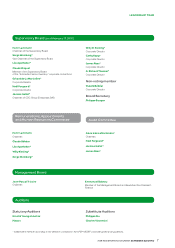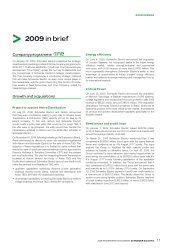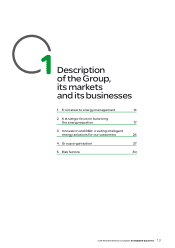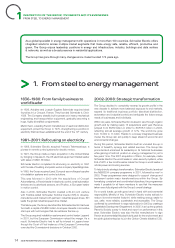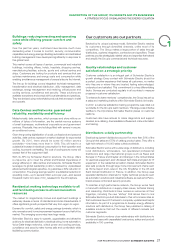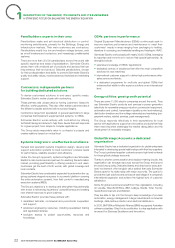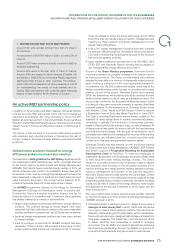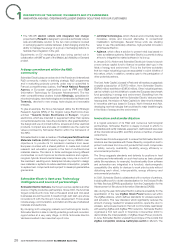APC 2009 Annual Report Download - page 19
Download and view the complete annual report
Please find page 19 of the 2009 APC annual report below. You can navigate through the pages in the report by either clicking on the pages listed below, or by using the keyword search tool below to find specific information within the annual report.
2009 REGISTRATION DOCUMENT SCHNEIDER ELECTRIC 17
DESCRIPTION OFTHEGROUP, ITSMARKETS ANDITSBUSINESSES
1
A STRATEGIC FOCUS ON BALANCING THEENERGYEQUATION
A critical challenge for our planet
In a world undergoing profound changes and facing a global
economic and fi nancial crisis, Schneider Electric has identifi ed six
major trends that it intends to leverage to drive long-term growth:
•energy’s critical role in the future of our planet. By 205 0,
global energy consumption is expected to double, while CO2
emissions are to be halved. This will clearly result in extremely
strong demand for energy management and energy effi ciency;
•the emergence of new economies. The world’s centre of
gravity is shifting. Mature markets are being supplanted by
new economies that provide signifi cant growth opportunities in
emerging countries;
•increased connectivity . From wireless telephones to the
Internet to home automation, technology is constantly making
communication easier and faster. The networking trend is growing
worldwide, offering a promising technological environment for
companies that can deliver the necessary solutions, products
and services;
•globalisation of economies and trade. In the last two decades,
people have completely changed the way they trade, think of
economic development and collaborate with stakeholders. A
global enterprise like Schneider Electric can leverage decisive
strengths to meet these new challenges;
•focus on simple solutions . No matter how technical products
or solutions may be, users want them to be easy to install, use
and maintain. Over the past fi ve years, Schneider Electric has
broadened its business portfolio and line up to make life easier
for its customers;
•demand for security. Customers and stakeholders want to have
access to reliable and safe energy that keeps their installations,
infrastructure and equipment operating at an optimal level. To
meet their demands and requirements, manufacturers must have
innovative, high performance products, solutions and services.
Beyond these trends, the energy challenge remains the most
important issue for our planet’s future. As natural resources become
scarcer, economic growth is not only possible, but absolutely
necessary. That said, it will require new ground rules that everyone
will have to follow.
A few fi gures paint a clear picture of the changes in progress :
•the world’s population is projected to increase by two billion by
2030;
•two billion people are expected to attain a middle-class standard
of living by 2020;
•twenty billion computers will be connected to the Internet by
2030;
•nearly two billion people are waiting to gain access to electricity.
At the same time, the energy mix is unlikely to shift substantially in
the next 25years unless radical changes are made much faster than
expected. Projections show that fossil fuels will continue to account
for nearly two-thirds of the mix in 2030.
To sum up:
•consumption of energy will double between now and 205 0 if
nothing is done;
•CO2 emissions need to be cut in half by 2050 to limit climate
change.
To balance this equation, the world has decided to take action
rather than sit back and wait. Even though the United Nations
Climate Change Conference in Copenhagen in 2009 did not
resolve everything, regulations and incentives are gradually being
deployed across the planet to encourage energy effi ciency and the
development of renewable energies. Examples of political action
include France’s Environmental Summit, the United States’ green-
inspired recovery programme , China’s new fi ve-year plan with its
strong environmental focus, and the European Union’s 20/20/20
plan. The development of hybrid vehicles and photovoltaic panels
attests to an unprecedented shift in public opinion, as does the
success of initiatives introduced alongside the Copenhagen summit.
Businesses have also chosen to go green, in part to burnish their
environmental credentials, but mostly because of the increasingly
large return on investment delivered by energy effi ciency projects.
In addition to this rising awareness, the basic model of energy supply
and demand is about to change radically, with efforts to decarbonize
the electricity supply, the rebirth of nuclear power, the development
of renewable energies, the deregulation and diversification of
electricity suppliers, interconnections between European countries
and the overarching need for energy effi ciency at all the links in the
energy chain. The industry is shifting from a simple, linear model of
centralised power generation and passive consumers to a much
more complex model combining centralised and distributed power
production, fossil fuels and renewable energies on the supply side,
and customers who actively adjust their consumption on the demand
side. The emergence of the new Smart Grid is impacting the entire
value chain from production to consumption.
The challenge, therefore, is to balance a complex, diffi cult-to-resolve
energy equation shaped by several variables. To meet regulatory,
environmental and profitability requirements, energy must be
safe, reliable, effi cient, productive and green. Effi ciency requires
an integrated approach that takes into account an entire system,
not just the individual components. The era of intelligent energy
management has dawned, and Schneider Electric, with its unique
business portfolio, is in a position to play a major role.
>
2. A strategic focus on balancing
theenergyequation


